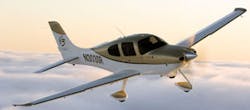May 8 -- Cirrus Design Corp. already produced the best-selling aircraft in the world, but it wasn't satisfied. The Duluth-based company just revealed a lighter, more agile version of the plane with a longer flying range than anything it has ever produced -- the SR22-G3.
Although David Coleal, Cirrus' president and chief operating officer, is proud of the newest airplane, he acknowledged that its birth was difficult.
The aircraft was in the planning stages for 16 months. It required more than 60,000 hours of engineering, 600 new parts and the creation of 450 new specialized fabrication tools.
Cirrus underestimated the complexity of getting the G3 into production.
"We've shifted our launch date several times," Coleal said, noting that Cirrus originally planned to unveil the G3 last year.
The new airplane features a redesigned wing, incorporating a carbon spar that enabled the SR22 to shed more than 50 pounds.
Cirrus had to set up an entirely new wing-manufacturing line to get the G3 off the ground.
But first, workers had to relocate existing operations. Tom Bartoe, Cirrus' executive vice president of operations, said workers rose to the challenge, repositioning the entire line in two days, then rapidly resuming production.
"Most companies can't move like that," said Coleal, who considers the nimble feat a testament to workers' phenomenal commitment. He said Cirrus' staff has worked a lot of overtime in recent weeks to make sure the company didn't miss a beat.
"When something needs to get done, we all do what it takes," said Matt Wheeler matter-of-factly, as he worked on the underside of a G3's fiberglass wing Monday morning.
Coleal said he appreciates the can-do spirit workers bring to their jobs.
"We're fortunate to have such a dedicated group of people who really put their heart and soul into the job," he said.
The new wing line was installed in the old line's former space. It features conveniently placed ovens used to cure the fiberglass wings. Previously, workers had to roll the wings on carts to distant ovens -- an arrangement that resulted in "a very convoluted work flow," according to Coleal.
The new line also sped up production with the help of computerized equipment that automatically carves sheets of fiberglass into patterns that previously were cut by hand, using jigs and routers.
New tools also were installed in Grand Forks, N.D., where Cirrus has a plant that manufactures airplane fuselages and other components.
Cirrus employs about 300 people in Grand Forks, compared with 870 in Duluth.
The combined plant improvements cost "several million dollars" Coleal said, and have enabled Cirrus to boost its production to 16 airplanes per week. Its previous weekly high was 15.
But Cirrus will need to make up ground to match its performance last year.
During the first quarter this year, Cirrus delivered 144 airplanes to customers -- down 9.4 percent from the same period last year.
Coleal said he's not worried. He said that considering the complexity of launching the G3, some decline in first-quarter production was to be expected.
On the bright side, Coleal said the first quarter is traditionally the weakest of the year for Cirrus.
For now, Cirrus will continue to operate two separate wing lines -- one for the new SR22 and another for the older SR20 -- but eventually the two airplanes will share a similar wing, enabling Cirrus to streamline operations.
The 35-foot-long carbon spar at the heart of Cirrus' wing redesign comes from a supplier in Utah. Cirrus had to design special carts that would protect the $10,000 spars during shipping.
To ensure their structural integrity, Cirrus takes a randomly-selected spar from each shipment, immerses it in water, then uses an ultrasound sensor to probe for defects. Eventually, Coleal aims to help the spar supplier develop a certified system for screening a product in-house before it is delivered to Cirrus. He called this a "dock-to-stock" system.
Coleal said carbon has proven to be a complex material to work with, but he expects to see many more carbon components as Cirrus works to develop a personal jet. For that reason, he called the development of the G3 "a great segue."
"Everything we've learned about processing this material will help us as we continue to use carbon where it makes sense," he said.
Cirrus is expected to unveil its concept design for a new single-engine jet, selling for about $1 million, later this summer.
Copyright (c) 2007, Duluth News-Tribune, Minn. Distributed by McClatchy-Tribune Information Services. For reprints, email , call 800-374-7985 or 847-635-6550, send a fax to 847-635-6968, or write to The Permissions Group Inc., 1247 Milwaukee Ave., Suite 303, Glenview, IL 60025, USA.
Copyright 2005 LexisNexis, a division of Reed Elsevier Inc. All rights reserved.
Terms and Conditions | Privacy Policy
News stories provided by third parties are not edited by "Site Publication" staff. For suggestions and comments, please click the Contact link at the bottom of this page.






